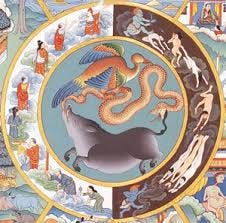This is the beginning of a longish piece that I’m publishing in two or three parts. This introductory part explores the relationship between karma and medicine. The next section(s) will go deeper, getting into the role of ritual as therapeutic intervention and coming around to some conclusions I hadn’t foreseen. I hope you’ll stick around for the ride. -JEd
What causes disease?
It’s a hopelessly broad question, granted. But play the game for a moment.
We might say diet. Physical activity or its lack. Pathogenic organisms. Stress.
Genetics and constitution. Environmental toxins. Socioeconomic factors like poverty and racism.
That ever-popular candidate for the root of all evils, late-stage capitalism (a formulation that always makes an economic system sound like a cancer).
We may have our preferred theories, but we can probably agree that there’s no one, final answer to such a question. Life’s too complex for that. Multiple causes co-exist at different levels.
At one level, Ring Dings can be said to cause cavities and diabetes. But what’s behind this pathogenesis? Sugar’s one cause; the sugar-eating behavior is another. And what causes that? On back we go, further upstream.
To cut to the chase, Tibetan physicians maintain that all disease is ultimately caused by the three “mental poisons” of greed, hatred and ignorance (symbolized by a rooster, snake and pig, respectively).
How these impurities lead to questionable decisions and bad habits is a process we’re mostly pretty familiar with. We mostly get that sooner or later our indiscretions show up downstream, in the body. With time, beer craving becomes beer belly.
One of the subtlest levels of explanation is that of karma, the fruiting of seeds once sown. The general view common to Buddhist and Hindu thinkers is that misfortunes not attributable to recent choices are results of past-life choices whose karmic fruits are now ripe.
If for instance a woman who leads an exemplary life falls ill with a rare cancer in her thirties, the supposition is that some bitter karmic fruit from a prior incarnation is ripening for her: every fruit comes from a seed. Now, it may be her karma to die young, or it may be for her to experience a remarkable recovery, perhaps one that inspires others or that gives the afflicted a transformative new lease on life. Perhaps a new cancer cure is discovered in the process, or a poem that will move millions written from the hospital bed: all part of the mysterious, wheels-within-wheels workings of karma (or destiny, or wyrd).
Of course, all this karma business assumes a multi-lifetime view that not everyone is comfortable with. Even those of us who seriously entertain the idea of reincarnation (or “the transmogrification of souls,” as they used to say), might wonder: what's the point of medicine if it's all a matter of karma?
One answer is that karma (technically, karma phala, the ‘fruits’ of past action) comes in many types, somewhat like rocks in a river.
Some pieces of karma are giant boulders. We can't reasonably hope to move them; at best we might back-paddle to soften the impact when we run into them, as we inevitably will. These karmas are said to be ‘fixed’ (drdh) and amount to major ‘scheduled events’ in our lives.
Others are mere pebbles, hardly worth bothering about. These are said to be non-fixed (adrdh) and are often more like background noise.
Still others are sizable rocks whose impact is significant, but that can be shifted through concerted effort. (More on that in parts II and III.) These are called fixed / non-fixed, or in-between (drdhādrdh). This middle ground is where things get interesting, in one sense.
To the best of my understanding, here’s how it is with illness. Sometimes the rock can be moved easily. Other times with difficulty. Other times it can't be moved at all, even with the longest lever we can muster. Most of the time we don't know until we try.
The physician’s duty, then, is to give the patient the benefit of the doubt and assume the illness may be amenable to treatment. The better to make the most of any karmic leeway present (and perhaps chalk up a little merit on the physician’s own karmic scorecard). Arjuna (of Bhagavad Gita fame) would approve, right? As humans we must strive to fulfill our dharma—righteous duty—surrendering the incalculable results to the divine.
This is all in the realm of best practice, clearly. But for the esoteric medical practitioner, there is also another road open: studying the karmic patterns themselves at a level upstream from symptomatology.
Even in our age of rationality, a cast of the yijing, a throw of the bones, or a heavenward glance can reveal something of the forces and patterns behind the illness or other issue, just as these methods have been doing for ages.
The living world didn’t stop speaking just because bipeds (many of us) stopped listening. Ancestral traditions haven’t disappeared with the rise of silicon or the narrowing of full-spectrum consciousness down to a rational laser-beam.
Divination within a medical context can open up new vistas of possibility and may end up transforming the practitioner’s—and patient’s—view of what constitutes medicine in the first place.
We’ll explore further in upcoming parts.



